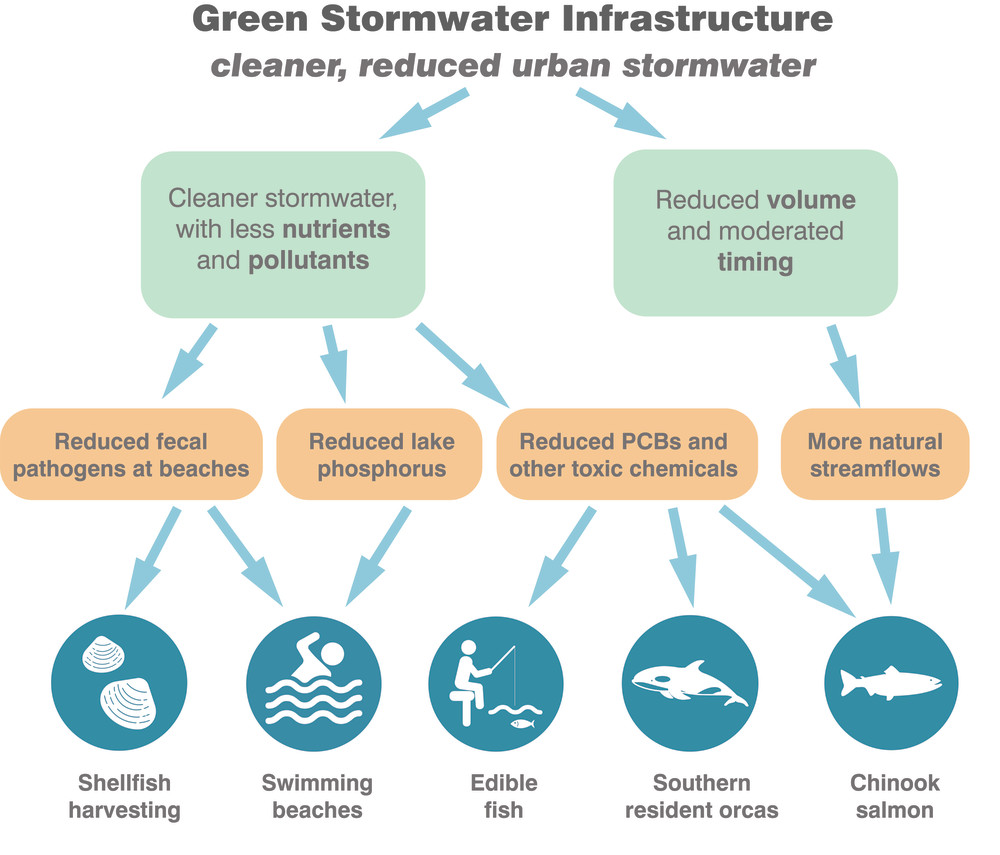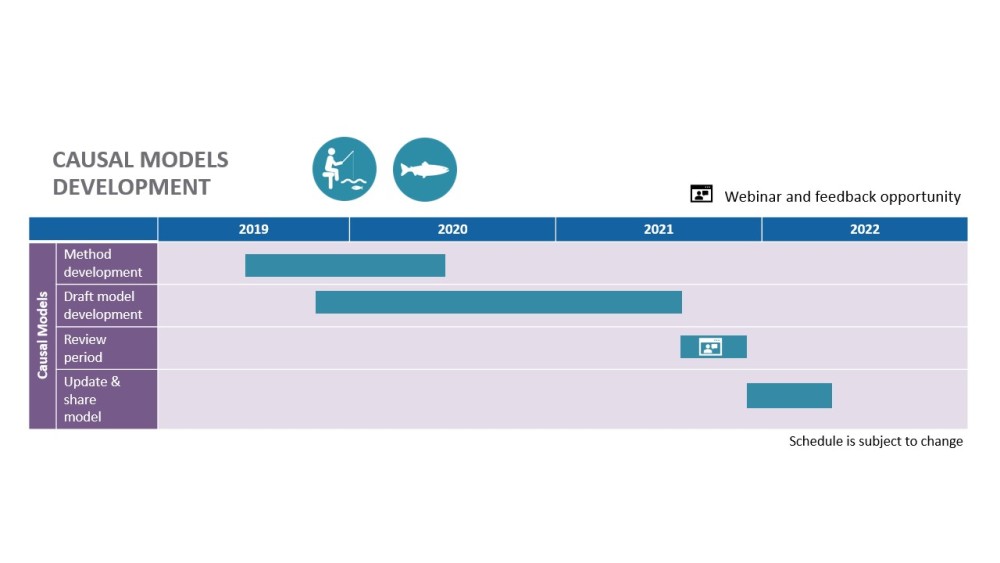Water Quality Benefits Evaluation Toolkit – Causal Models
Water Quality Benefits Evaluation Toolkit – Causal Models
CAUSAL MODELS
King County is committed to making big investments in water quality over the next decade. The Water Quality Benefits Evaluation Toolkit will support the County in identifying water quality improvements that are effective at reducing pollutants and protecting ecological and human health.
The causal models help identify the most important factors influencing some of the ‘endpoints’ we care about, like the condition of swimming beaches, shellfish beds, toxics in edible fish, and Southern Resident orcas. By estimating the potential benefit of different water quality investments to these endpoints, the causal models can help identify outcomes-based priorities for our work.
From May 6 through May 28 2021, the WQBE Team, in King County’s Science and Technical Support Section, invited input on four causal models that are part of the WQBE Toolkit. The WQBE team used the feedback we received to:
- Help identify any gaps to ensure we produce a robust Toolkit to inform King County planning efforts.
- Hear whether there was interest in using information from the Toolkit for your work.
- Flag any additions or improvements that could be incorporated in this phase of modeling or in future efforts.
Thank you to those of you who provided feedback on the causal models! Please visit the tabs below for updates on how that feedback was incorporated into the models and stay tuned for a written report. On October 18, the WQBE team held another webinar on the edible fish and Chinook models, with brief updates on the other models.
How to use this site
Read the overview on the first tab here, then visit each tab to learn more about the models.
WQBE causal models:
- Algal toxins at swimming beaches (review period ended May 2021)
- Fecal contamination at swimming beaches (review period ended May 2021)
- Fecal contamination at shellfish beds (review period ended May 2021)
- Southern Resident orca population health (review period ended May 2021)
- Toxics in edible fish (review period ended November 2021)
- Chinook salmon populations (review period ended November 2021)
Causal models overview
Watch an overview presentation about the causal models from the May 6, 2021 webinar presented by Carly Greyell (project manager).
The causal models help identify the most important factors influencing some of the ‘endpoints’ we care about, like the condition of swimming beaches, shellfish beds, toxics in edible fish, and Southern Resident orcas. By estimating the potential benefit of different water quality investments to these endpoints, the causal models can help identify outcomes-based priorities for our work.
Proof of concept example
What are causal models?
Causal models are computational models that describe the cause-and-effect relationships between influencing factors (such as levels of pollutants) and the condition of an endpoint (for example, population health of Southern Resident orcas). The causal models help to understand how changing one factor might positively or negatively impact the endpoint and to what extent.
For the swimming beaches, shellfish beds, and orca endpoints we are using Bayesian networks for these models. Bayesian networks are computational models that use probabilities to describe cause-and-effect relationships and meaningful correlations between factors. They can be used to predict the probability of a specific endpoint response given the probability of changes in the condition of influencing factors. Bayesian networks can account for varying magnitudes of influence, can handle data gaps, and are easily adaptable so that models can be improved over time.
Timeline for causal models available for review
Swimming beaches, shellfish harvesting, and Southern Resident orca models:
Edible fish and Chinook salmon models:
Why are we developing causal models?
Traditionally, water quality benefits are described in terms of pollutant reduction, but this on its own does not account for outcomes. The WQBE Toolkit includes pollutant loading models and the SUSTAIN model to help us understand the potential for pollutant reductions, but the causal models help us connect this to expected outcomes for people, salmon, and orca. The type of pollutant and where and when the reduction occurs has a big influence on potential outcomes. For example, reducing bacteria at a swimming beach in the summer has a different human health outcome than reducing bacteria in a river in the winter.
Making decisions based on outcomes requires a detailed understanding of complex cause and effect relationships. The WQBE causal models make this information accessible by distilling expert knowledge about these relationships into a tool that allows users to estimate the potential outcomes of different resource management scenarios. This provides decision-makers access to detailed technical information in a format that can be used to weigh the benefits and trade-offs of potential investments.
How will the causal models be used?
We think this is useful information for a wide-range of efforts, but in the near-term, these models are one way King County will help evaluate water quality for the Clean Water Plan. The Clean Water Plan will use causal model outputs, along with other water quality, financial, equity, sustainability, community, and system health evaluations, to explore outcomes of different approaches for investing in the regional wastewater system and regional water quality.
We are also coordinating with King County’s Stormwater Services to explore how these models could inform retrofit prioritization that is based on the potential outcomes that could be achieved through stormwater management (for example “where should we prioritize stormwater treatment for bacteria in order to benefit specific beaches or shellfish beds?”).
These models, and the WQBE Toolkit as a whole, do not solely drive decisions about potential investments, but instead they generate information that can be used as part of a larger decision-making process or prioritization framework.
The specific questions that can be answered differ for each causal model. Please visit the pages for each model endpoint to find details about capabilities and limitations of the models.
Read our background documents on model development:
- Details about how the endpoints were selected.
- Details about how the causal model framework (Bayesian networks) was selected.
- Details about the guiding methods for model development.
- Details about how the model foundations (conceptual models) were developed for each endpoint.


